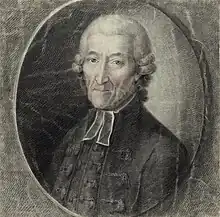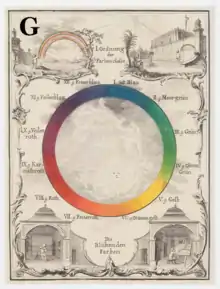
Jeremias (Johann) Ignaz Schiffermüller (2 November 1727, Hellmonsödt – 21 June 1806, Linz) was an Austrian naturalist and Jesuit teacher who took a special interest in the Lepidoptera. In order to describe the colours of butterflies, he also looked for a systematic approach to describing colours in nature and to standardize their names. The moth Tinea schiffermullerella was named after him but the name is no longer valid.
Life and work
Schiffermüller was born in Hellmonsödt near Linz. The baptism record notes the name as Jeremias Ignatio, he was the eighth of ten children of master brewer Leopold Schiffermiller and Maria née Margottin. Jeremias Mitterbauer a meat seller was his godfather.[1] After studies at Linz he joined the Jesuit order in Vienna at the age of nineteen. From 1752 to 1754 he taught at the Passau Grammar School. He became a teacher at the Theresianum College in Vienna in 1759 and worked there for fifteen years. During this time he took an interest in natural history, collecting specimens of butterflies. His collection was presented to the old United Royal and Imperial Natural History Collections (Vereinigtes k.k. Naturalien-Cabinet) at the Hofburg where it burnt during the revolution in 1848. With Michael Denis, also a teacher at the Theresianum, he published the first index of the Lepidoptera of the Viennese region in the book Das Systematische Verzeichnis der Schmetterlinge der Wienergegend herausgegeben von einigen Lehrern am k. k. Theresianum (1775). Another work titled Ankündung eines systematischen Werkes von den Schmetterlingen der Wienergegend (1775) was distributed privately to various people including Carl Linnaeus. The work did not explicitly state his name as an author but described 1150 species. Because this work also included the names of some new butterfly species, it caused some nomenclatural problems for taxonomists.[2][3][4] His collection is in the Kaiserlichen Hof-Naturalienkabinett (now Naturhistorisches Museum Wien). In 1775 he was named a royal councilor and he moved to Linz, living there until his death.[1][3]

Colour system
Schiffermüller is noteworthy for his work in developing a scientifically based colour nomenclature to aid the description of butterfly coloration.[5]
In his Versuch eines Farbensystems (1772), Schiffermüller addressed the need for a standardised nomenclature with which to describe the countless colours of nature. Work by predecessors in this field had proved unsatisfactory: he mentions suggestions made by Giovanni Antonio Scopoli (1723–1778) in his Entomologia Carniolica (1763) and August Johann Rösel (1705–1759) in his Insecten-Belustigung (1746–61). He made use of the work of L’optique des couleurs by the French Jesuit Louis Bertrand Castel (1688–1757). He included a colour circle for the saturated colours which he termed as “blühende Farben” (florid colors). He then tried to define tints of each colour. To serve as a model, Schiffermüller himself presents a table classifying and sub-classifying shades of blue, and naming them in German, Latin and French: in all, 81 German terms are listed. Matching this table, and using the same alphabetical notation, is a 3 x 12 matrix showing a set of colour samples for blue, with some discussion of the pigments used.[6][7]
Works
- Versuch eines Farbensystems, Vienna 1772[8]
References
- 1 2 Speta, Franz (1988). "Ignaz Schiffermüller, in seiner Heimat vergessen!" (PDF). Das Mühlviertel – Natur Kultur Leben (in German): 141–146.
- ↑ Kudrna, O. (2015). "The never ending story of Schiffermüller's names - a long evaded nomenclatural issue of pressing urgency and a special case for the ICZN (Insecta: Lepidoptera)" (PDF). Quadrifina. 12: 17–26.
- 1 2 Tóth, Balázs; Katona, Gergely; Bálint, Zsolt (2020-07-31). "Considerations on the historic context surrounding the publications attributed to Denis & Schiffermüller". Nota Lepidopterologica. 43: 173–179. doi:10.3897/nl.43.48374. ISSN 2367-5365.
- ↑ Bálint, Zsolt (2023). "Schiffermüller and the Jesuit lepidopterists of the 18 century: further notes on the "Wiener Systematisches Verzeichniss"". Lepidoptera Novae. 16 (2): 115–126.
- ↑ Shamey, Renzo (2020). "Schiffermüller, Ignaz 1727–1806". In Shamey, Renzo; Kuehni, Rolf G. (eds.). Pioneers of Color Science. Cham: Springer International Publishing. pp. 119–122. doi:10.1007/978-3-319-30811-1_25. ISBN 978-3-319-30811-1. S2CID 238082673.
- ↑ Kuehni, Rolf G. (2010). "A brief history of disk color mixture". Color Research & Application. 35 (2): 110–121. doi:10.1002/col.20566. ISSN 0361-2317.
- ↑ Werner Spillmann ed. (2009). Farb-Systeme 1611-2007. Farb-Dokumente in der Sammlung Werner Spillmann. Schwabe, Basel, ISBN 978-3-7965-2517-9, pp. 28–31; William Jervis Jones (2013). German Colour Terms: A study in their historical evolution from earliest times to the present. John Benjamins, Amsterdam & Philadelphia, ISBN 978-90-272-4610-3, pp. 213–218.
- ↑ Versuch eines Farbensystems at Openlibrary.org Retrieved on 25 June 2009.
External links
- "Schiffermüller's Color System," Sarah Lowengard, The Creation of Color in Eighteenth-Century Europe Gutenberg-e series, (New York: Columbia University Press, 2006) http://www.gutenberg-e.org/lowengard/C_Chap57.html
- Groll, E. K. (Hrsg.): Biografien der Entomologen der Welt : Datenbank. Version 4.15 : Senckenberg Deutsches Entomologisches Institut, 2010